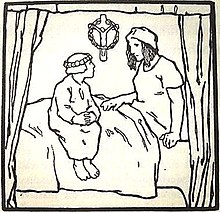The Shroud (fairy tale)
The Shroud, (Das Totenhemdchen): KHM 109, also known as The Burial Shirt and The Little Shroud, is a German fairy tale collected by the Brothers Grimm and published in the first edition of Kinder- und Hausmärchen (Grimm's Fairy Tales) in 1815. It contains elements of Aarne–Thompson type 769: The Death of a Child.[1]

Story
The tale was translated by Margaret Raine Hunt in 1884:
There once a mother who had a little boy of seven years old, who was so handsome and loveable that no one could look at him without liking him, and she herself worshipped him above everything in the world. Now it so happened that he suddenly became ill, and God took him to himself; and for this the mother could not be comforted, and wept both day and night. But soon afterwards, when the child had been buried, it appeared by night in the places where it had sat and played during its life, and if the mother wept, it wept also, and when morning came it disappeared. As, however, the mother would not stop crying, it came one night, in the little white shroud in which it had been laid in its coffin, and with its wreath of flowers round its head, and stood on the bed at her feet, and said, "Oh, mother, do stop crying, or I shall never fall asleep in my coffin, for my shroud will not dry because of all thy tears, which fall upon it." The mother was afraid when she heard that, and wept no more. The next night the child came again, and held a little light in its hand, and said, "Look, mother, my shroud is nearly dry, and I can rest in my grave.” Then the mother gave her sorrow into God's keeping, and bore it quietly and patiently, and the child came no more, but slept in its little bed beneath the earth.[2]
Analysis
The Shroud was originally No. 23 in Volume 2 of the 1st edition (1815). It had only a few minor alterations between 1815 and the final edition (1857). It has been No. 109 in the order since the second edition of 1819.[1]
In a time of high mortality rates among children, through the story we are taught that just as the distraught mother learns to put her trust in God and control her grieving so too must we when we suffer a death otherwise the spirit of the departed cannot rest. In the end both characters find peace.
References
- 'The Burial Shirt' - Grimm Project - University of Pittsburgh
- Jacob and Wilhelm Grimm, Household Tales, translated by Margaret Raine Hunt, London: George Bell (1884)
| This work is in the public domain in the United States because it was published (or registered with the U.S. Copyright Office) before January 1, 1925. |